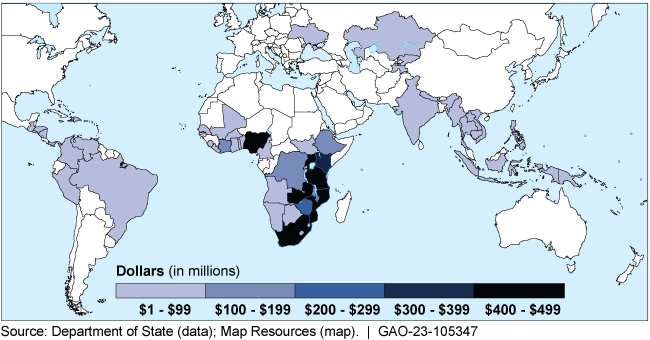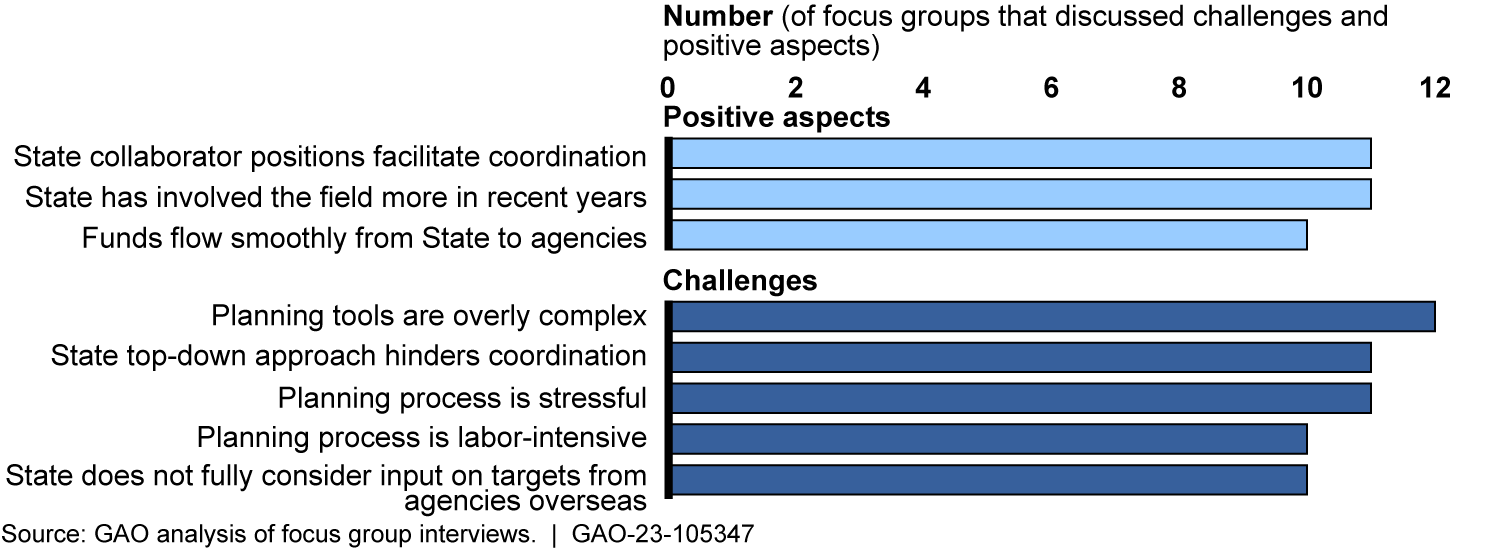President's Emergency Plan For AIDS Relief: State Has Taken Actions to Address Coordination Challenges, but Staffing Challenges Persist
Fast Facts
Since 2003, the President's Emergency Plan for AIDS Relief has provided over $100 billion for combating HIV/AIDS and saved an estimated 20 million lives.
The State Department oversees about $6 billion a year in program spending across U.S. agencies in over 50 countries. Agencies have said that State's top-down culture and complex planning process have hampered program implementation.
State has announced significant changes to improve coordination. However, State has not addressed the causes of persistent program staffing vacancies and could better coordinate its funding policies with agencies. Our recommendations address these issues.
The President’s Emergency Plan for AIDS Relief funded activities to combat HIV/AIDS in these countries in FY 2022.

Highlights
What GAO Found
For a number of years, persistent challenges have affected coordination between the Department of State and overseas federal agency officials implementing the U.S. President’s Emergency Plan for AIDS Relief (PEPFAR). Overseas officials identified such challenges that hinder implementation. These include complex country operational planning (COP) tools that overseas officials are required to use and the “top-down” culture of State’s Office of the U.S. Global AIDS Coordinator and Health Diplomacy (S/GAC). GAO reported on similar issues in 2004. S/GAC recently took actions to improve coordination by, for example, involving overseas officials more in the COP process. Since 2020, S/GAC has taken further actions by collecting feedback from overseas officials and convening a COP reform task force in summer 2022. These efforts resulted in S/GAC announcing significant changes in August 2022 to its COP processes to address coordination concerns.
Positive and Challenging Aspects of Coordination, Funding, and Staffing Most Commonly Discussed in Focus Groups of U.S. President’s Emergency Plan for AIDS Relief (PEPFAR) Agency Officials Overseas

Persistent PEPFAR staffing vacancies have led to heavy workload and retention issues, but S/GAC has not identified or addressed their underlying causes. Seventy percent of S/GAC’s headquarters positions are vacant and 89 percent of key overseas positions are filled on an “acting” basis. Key principles for effective workforce planning include developing strategies to address human capital gaps. S/GAC uses its annual COP documents for workforce planning, but these documents do not address program-wide staffing gaps and their causes. Without a strategic workforce planning process, PEPFAR officials may continue to face heavy workloads hindering effective implementation.
S/GAC generally transfers PEPFAR assistance funds to agencies before the start of the COP implementation period, but implementing agencies’ processes and varying policies have created funding challenges. In addition, while implementing agencies overseas rely on funding pipelines to keep programs operating while awaiting funding or to address HIV hotspots, agency officials said that S/GAC’s pipeline policy could result in insufficient funds for implementing ;partners to conduct activities. Further, S/GAC’s and the U.S. Agency for International Development’s (USAID) policies on pipeline funds vary, which could also result in insufficient funds to support implementing partners’ activities.
Why GAO Did This Study
Since its inception in 2003, PEPFAR has provided more than $100 billion to address HIV/AIDS in over 50 countries, according to the U.S. government. S/GAC oversees and directs about $6 billion annually in support of PEPFAR programs implemented primarily by USAID, the Department of Health and Human Services, and the Department of Defense.
GAO was asked to review the operation of the PEPFAR program. This report examines (1) coordination between S/GAC and U.S. implementing agencies overseas, (2) staffing vacancies, and (3) any delays in funding distributions. GAO analyzed PEPFAR documents and data and interviewed agency officials in Washington, D.C. GAO also conducted 12 focus groups with officials implementing PEPFAR programs in six countries. GAO selected these countries because their programs collectively represent 41 percent of total PEPFAR funding in fiscal year 2022 and include countries with both relatively small and large PEPFAR programs.
Recommendations
GAO is making three recommendations, that State should develop a strategic workforce planning process, and that State and USAID should ensure their funding pipeline policies are compatible. State and USAID agreed with the recommendations.
Recommendations for Executive Action
| Agency Affected | Recommendation | Status |
|---|---|---|
| Department of State | The U.S. Global Aids Coordinator should develop a strategic workforce planning process to identify and address the underlying causes for persistent staffing vacancies in S/GAC headquarters and country teams. (Recommendation 1) |
Open
State noted that it would work with the appropriate entities within the department to develop and implement a strategic workforce process that identifies and addresses the persistent staffing vacancies in State headquarters and in country teams. As of May 2023, State noted that senior management at the U.S. Office of Global AIDS Coordinator (S/GAC) continues to build out a strategic workforce plan. Roles critical to supporting strategic workforce planning have been filled, and the incoming Chief of Staff, Principal Deputy Coordinator, and Deputy Executive Director of Management and Operations, will assist with progress toward S/GAC's human capital goals. These individuals will address remaining staffing gaps and ensure alignment with effective strategies as outlined in GAO's Human Capital: Key Principles for Effective Strategic Workforce Planning.
|
| Department of State | The U.S. Global Aids Coordinator should work with USAID to ensure that State's funding pipeline policies are compatible for PEPFAR activities and that adequate pipeline funds are available to implementing agencies so that these activities can continue in case of funding delays. (Recommendation 2) |
Open – Partially Addressed
State noted that it had been working with USAID and other PEPFAR implementing agencies to notify a portion of planned country operational planning (COP) funding early to ensure that agencies have funding on hand if planning processes are delayed, in order to prevent disruptions to activities. In June 2023, State provided an update and documentation on actions to address this recommendation. Specifically, State noted that it had reached an agreement with USAID and other PEPFAR implementing agencies for calculating the fiscal year end pipeline that is more aligned with USAID policies regarding accrual accounting. These changes are reflected in updated country operational planning (COP) guidance. The updated COP guidance now allows pipeline funds to be used to pay for prior year costs, and according to State, this adjusted calculation provides a more accurate estimate of funds that may be applied to future implementation cycles.
|
| U.S. Agency for International Development | USAID should work with the U.S. Global Aids Coordinator to ensure that USAID's funding pipeline policies are compatible for PEPFAR activities and that adequate pipeline funds are available to implementing agencies so that these activities can continue in case of funding delays. (Recommendation 3) |
Open – Partially Addressed
As of March 2023, USAID officials said that they plan to coordinate with State on funding pipeline policies to ensure that sufficient funds are available, especially as USAID continues to shift programming to local partners. In June 2023, USAID provided an update on actions to address this recommendation. Specifically, USAID noted that it had reached an agreement with State and other PEPFAR implementing agencies for calculating the fiscal year end pipeline that is more aligned with USAID policies regarding accrual accounting. These changes are reflected in updated country operational planning (COP) guidance, provided by State. The updated COP guidance now allows pipeline funds to be used to pay for prior year costs, and according to USAID, this adjusted calculation provides a more accurate estimate of funds that may be applied to future implementation cycles. USAID also noted that it will continue collaborating with State to advocate for an increased number of months of "allowable" pipeline, especially for local organizations. This would bring State's pipeline policy more in line with local compensation plans, and with USAID's pipeline policies, according to USAID. As of February 2024, USAID noted that the agency is currently working with State to expedite the timeline for available funds using the State/GHSD PEPFAR COP 2023 Year 2 update and ROP23 Year 1 process. USAID requested additional time to facilitate alignment between State and USAID responses to the recommendation, and is working to complete this alignment by June 2024.
|
